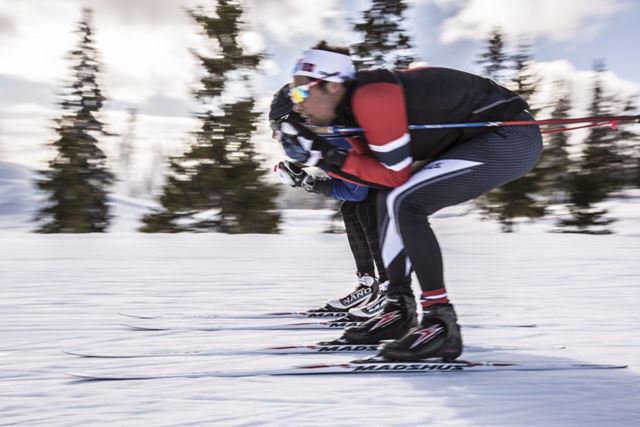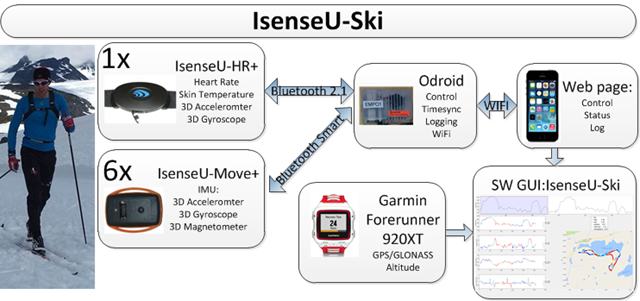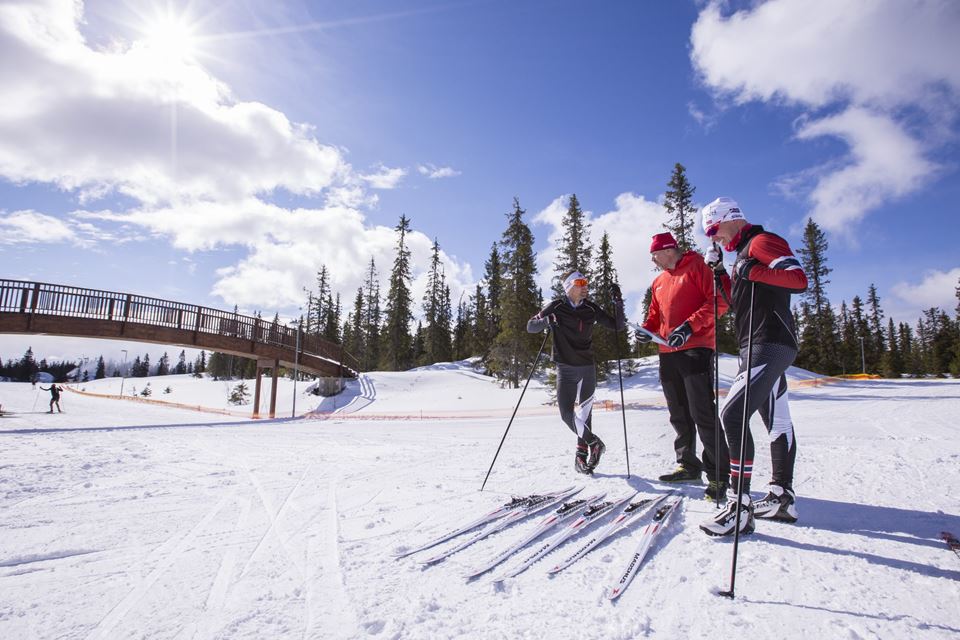This is why some of Norway’s very best skiers, and a team of super-fit recreational skiers, underwent training sessions this winter – with researchers tracking their every move.
Results from the outdoor lab have provided both the sports scientists and the norwegian ski manufacturer Madshus with new insights into the skiers’ techniques and the attributes of their skis.
“It’s essential to give skiers feedback about how and why they gain or lose those valuable seconds”, says Øyvind Sandbakk at NTNU ( Norwegian University of Technology and Science). “Feedback often provides athletes with “a-ha” moments – insights they hadn’t thought of, and helps them to focus their priorities in future training sessions”, he says.
Sandbakk is a professor at NTNU’s Centre for Elite Sports Research, a dedicated skier himself, and Head of R&D at Olympiatoppen, the organisation responsible for developing Norway’s elite sportsmen and women.
Lab on the snow
SINTEF is behind the development of sensors now being attached to the skiers’ bodies. The results of this research have recently been published in the scientific periodical Sports Engineering, co-authored by SINTEF and its partners at NTNU.
The development of sensors and systems that can transmit data to the outside world is one of the main activities taking place at SINTEF Digital’s laboratories. Here, work is being carried out to make the sensors small and wireless, highly sensitive and accurate, as well as being robust and able to transmit data to waiting researchers. And that’s just for starters.
Facts:
Project title: Unike skiopplevelser basert på intelligente ski og smart fabrikk (Unique skiing experiences based on intelligent skis and smart manufacture.)
Project number: 245622/O30
Duration: 1. April 2015 to 30. September 2018
Sensor measurements obtained during winter training sessions at Sjusjøen represent valuable data that both Sandbakk and the ski manufacturer are keeping as a closely guarded secret. In fact, they could be sitting on a small goldmine. When the analysis is complete, these data will provide new insights about the skiers’ techniques and the links between technique and the properties of their skis. And hopefully ensure that cross-country skiers using Madshus skis will never again be able to complain about substandard equipment.
Hooked on bodies
Researcher and physicist Trine M. Seeberg has previously led the development of a series of sensor-based systems that use the human body as their test arena. She has seen the development of sensors that can provide continuous measurements of a medical patient’s blood pressure, as well as systems that can monitor the health of personnel with physically demanding jobs, such as smoke divers and fire-fighters.
If you want to know more about sensors used to monitor the human body, we recommend reading:
But this time, she has shifted her attention to the bodies and movements of elite Norwegian skiers, who are getting assistance and support to enable them to perform at their very best. Moreover, the data obtained will provide Madshus with valuable information about the attributes of the skis, all of which may be very useful input to the manufacture of new models.

Testing: Thomas Söderberg and Ole Martin Storlien. Söderberg has previously worked as a service man at the Norwegian Skiskytterlandslag. Storlien is a service man for Madshus in the World Cup cross country skiing. He is currently in South Korea to support the Norwegian cross-country team. Photo: Stefano Zatta.
The unique aspect of the sensor system is that it interconnects signals from many sensor modules that contain magnetometers, gyroscopes and accelerometers. And all in real time. This means that all movements are monitored precisely and without any time lapses. Being attached to the skier’s body, and his skis, enables the sensors to provide a picture of the athlete’s technique right down to the smallest detail. And all thanks to very precise synchronisation.
“Detailed logging of skiers’ training sessions shows their poling frequencies and the degree to which they employ diagonal stride. In other words, the data can reveal those subsidiary techniques at which an athlete excels, and record the frequency of his or her arm and leg movements”, says Seeberg. “And, not least, the frequency at which skiers alter their technique, seen in the context of the track they’re training on. All this combined with the speed of the skiers”, she explains.
“In fact, we’re now able to record skiers’ winning techniques and what happens when they sprint”, says Seeberg.
The researchers are also thinking of applying this technology in another health-related project involving the physical rehabilitation of patients, such as those suffering from MS.
“We’re now getting very precise data about even the smallest body movements”, says Seeberg. “This can be applied to develop more precise guidelines for patients who are training as part of their road to recovery, or in connection with so-called gamification, by which patients who wear sensors while they train obtain feedback as a means of motivation. Our aim is to obtain as much data as possible using as few sensors as possible”, she says.
The mysticism of opposites
The dataset also provides ski manufacturer Madshus with valuable input to the development of its ski manufacturing process. It is still the case that choosing a pair of skis is surrounded by an air of mysticism – by personal preference, experience and, not least, gut feeling. It is not an exact science.
“Because choosing skis is such an emotionally-driven process, we’re looking to identify a method that provides us with quantifiable parameters”, says Bjørn Ivar Austrem, who is Head of Development at Madshus, and was once a competitive alpine skier himself. “We believe that the huge dataset now being generated by the field researchers at Sjusjøen will make it possible to link the performance of the skis to their manufacture”, he says.

Austrem has also participated in many technology projects in collaboration with SINTEF, including the experimental use of RFID technology to monitor the production of individual skis. This means that the skis are produced with a precise specification of their properties, which in turn makes it easier for Madshus’ customers to make their choice.
Whant to know more about RFID? Read our story:
For the uninitiated reader: No two skis are exactly alike. Each has its own individual attributes. Moreover, a ski becomes deformed when we use it. So when you own a pair of skis, it pays to have them tailored to your weight and the technique you use. The aim is that your skis should not only provide as much glide as possible, but also as much grip as possible when you need it.
RFID technology enables every ski to be allocated its own “fingerprint” that tells us something about the attributes of the pair of skis you purchase.
However, the very best skiers demand more than just a “fingerprint” from their skis if the equipment is to help improve the athletes’ performance. Since the interaction between an individual skier’s technique and the properties of his or her skis are of major significance, the Madshus team has been skiing around the courses at Sjusjøen with six different sensors attached to their chests, arms and legs, and a mini-computer fitted in their hip-belts.
Technology and ethics
Professor Øyvind Sandbakk at NTNU is also deeply involved in the project. He has been conducting research into elite sportsmen and women for more than 10 years. Sandbakk and his colleagues at NTNU are now aiming to use the insights from this project to develop methods that can measure our skiers’ progress.

The stomachfeel is gaining scientific competition: In collaboration with the Center for Top-level Research at NTNU, researchers at SINTEF, Madshus will use new sensor technology to advance with individual skittlement for both elite practitioners and skimosionists. Here you can try different skis on Sjusjøen in February 2018. Photo: Stefano Zatta.
“What is unique about our current work is that we are able to measure the skiers’ overall and subsidiary techniques outdoors and compare the results with what we know about their individual physiologies”, says Sandbakk.
“This provides us with valuable knowledge that enables us quite simply to identify how the right choice of skis or better technique can improve a skier’s performance”, he says.
“ Isn’t the use of so much technology in sport becoming a form of cheating?”
“Of course it’s important to adhere to the rules and to continuously weigh up ethical considerations when making such developments”, says Sandbakk. “I believe that by doing so we’ll succeed in finding the right path in our pursuit of better performances”, he says.
“How will you be applying the results in practice?”
“We’re currently obtaining very precise data that will make it possible for us to observe minute changes in a skier’s performance”, he says. “If we see that an athlete is losing seconds in a given type of terrain, or because he’s using a certain type of subsidiary technique, we can focus priority in future training sessions on these perceived weaknesses”, says Sandbakk.
If the project bears fruit, it will not be long before our Norwegian cross-country skiers are competing using both super skis and ultra-honed techniques. So, to all our competitors – you have been warned!

